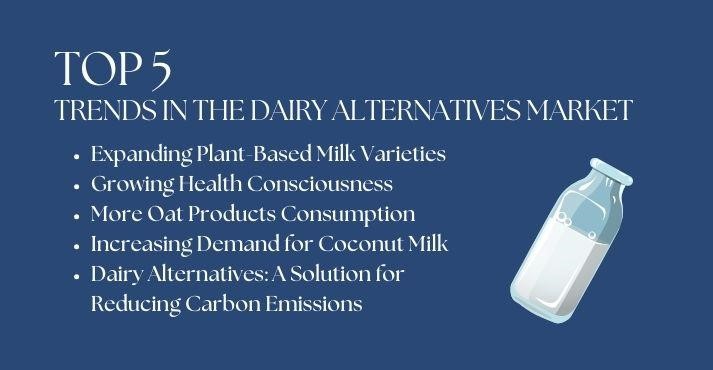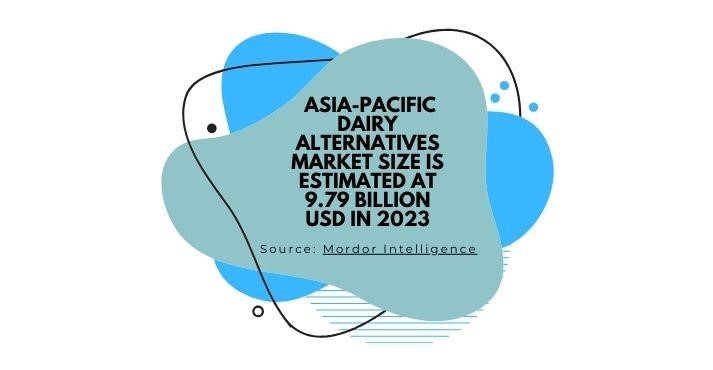The global food market has undergone a worldwide transformation in recent years.
As more people seek to reduce and eliminate dairy products from their diet, the dairy alternative products industry provides more choices for consumers.
According to the National Institutes of Health, approximately 65% of the population has difficulty digesting lactose, representing a large target population.
With the dairy alternatives market starting to mature, consumers are looking for products that fill this niche and provide a solution for consumers with hypercholesterolemia, milk allergy, or lactose intolerance.
Therefore, staying updated with the latest trends in this sector is essential for F&B businesses to stay competitive, foster innovation, and potentially reduce costs.
This blog will explore the top 5 trends in the dairy alternative market that you must know.
- Expanding Plant-Based Milk Varieties
- Growing Health Consciousness
- More Oat Products Consumption
- Increasing Demand for Coconut Milk
- Dairy Alternatives: A Solution for Reducing Carbon Emissions
Overview of the Dairy Alternatives Market

According to Future Market Insights, the alternative dairy products market is estimated to be valued at US$21.2 billion in 2023 and is predicted to grow at an estimated 8.3% GAGR from 2023 to 2033, reaching a value of US$ 47.1 billion in 2033.
The major players in the dairy alternatives market, according to the report of Markets and Markets, are:
- Danone North America Public Benefit Corporation (US)
- The Hain Celestial Group, Inc. (US)
- Blue Diamond Growers (US)
- SunOpta (Canada)
- Sanitarium (New Zealand)
Now, let’s explore the top 5 trends redefining the alternatives to dairy products in the market.
Top 5 Trends in the Dairy Alternatives Market

Driven by shifting consumer preferences, the Asia Food and Beverage Market is experiencing emerging trends in the dairy alternatives market.
Here’s a look at the 2023 dairy alternative market trends ahead.
1. Expanding Plant-Based Milk Varieties
The preferences for plant-based milk varieties continue to climb with the rising demand across consumer segments and the availability of diverse non-dairy milk options.
Plant-based milk is a safe and healthy choice among consumers with a dairy allergy and lactose intolerance. The plant-based dairy products market options are no longer limited to certain types. The popular choices include:
Soy Milk
Soy milk is either ground soybeans or soy protein powder, preferred for its rich protein content and creamy texture. Soy milk is a dairy-free calcium and vitamin D source, aiding bone health and providing cardiovascular benefits.
Almond Milk
Almond is made from ground almonds, loved for its mild, nutty flavor and low-calorie content. Almond milk is a plant-based dairy alternative that provides vitamin E for skin health and antioxidants for overall well-being.
Oat Milk
Oat milk is made by blending oats and water and then straining off the liquid. It is known for its neutral taste and creamy texture. Oat milk contains fiber and beta-glucans, aiding heart health and cholesterol management.
Rice Milk
Rice milk is made from milled brown rice and water, is preferred for its easy digestibility, and offers energy-sustaining carbohydrates.
Macadamia Milk
Macadamia milk is made by blending soaked macadamia nuts with water. It is creamy with a rich buttery flavor and contains monounsaturated fats, supporting heart health.
Pea Milk
Pea milk is made from yellow field peas milled into flour. It contains rich amino acids, which are beneficial for muscle growth and overall health.
Hemp Milk
Hemp milk is made by blending water and seeds from the Cannabis sativa plant. It contains omega-3 fatty acids that are beneficial for brain and heart health.
For example, Nestlé has unveiled its latest innovation for its plant-based products: a milk alternative that combines a unique blend of oats and fava with a solid nutritional value. This product delivers taste and nutrition to consumers seeking both.
2. Growing Health Consciousness
Worldwide, consumers are becoming more educated, more adventurous, and more open to healthy options available in the market.
Consumers look forward to maintaining a healthy lifestyle but refuse to compromise on taste. The rise of health consciousness is driven by a desire to prevent illness, enhance quality of life, and reduce healthcare costs.
Dairy-free substitutes are known to have fewer calories, more water content, less fat (except for coconut-based milk), more vitamins and nutrients, and less protein (except soy) when compared to cow milk.
As the awareness of dietary and nutrition grows, the market for fortified lactose-free products is expanding. Fortified lactose-free products are in demand for more inclusive and health-enhancing food options for consumers seeking alternatives with added vitamins, minerals, and nutrients.
As an example of adopting health-conscious consumerism, Ruby Tuesday, a leading restaurant chain across the globe, has added healthier options on their menu marked as ‘Fit & Trim’ and other varieties based on dietary needs, such as gluten intolerance.
3. More Oat Products Consumption

Oat consumption is gathering momentum, and suddenly, they are everywhere in the market. Oats contain over 9 different phytochemicals.
The popularity of oats continues to soar as they enter the world of milk due to their high nutritional value and proven to be good for physical health. The revenue from the global oat market is projected to be worth 8.37 billion U.S. dollars by 2028.
Consumers are charting oat milk as a protein, calcium, and Vitamin D source. Also, oat milk is ideal for consumers struggling to maintain ideal body weight.
The growing prominence of oat products has urged wholesale food suppliers to leverage the trend and cater to a widespread dairy-free beverage-consuming population.
For example, the UK-based coffee chain Costa Coffee has begun trailing a self-serve machine that uses only oat milk in response to the growing popularity of dairy alternatives among UK consumers.
Another excellent example of using oat milk in the Food and Beverage Industry is Dunkin Donuts, which has added vegan-friendly, gluten-free oat milk to their menus across their restaurants.
4. Increasing Demand for Coconut Milk
By 2026, the coconut milk market size is estimated to grow to 781 million U.S. dollars. The rising demand for lactose-free dairy alternatives provided promising opportunities in coconut milk.
The shift in consumers’ dietary preferences towards dairy alternatives has led to coconut milk, as it is recognized for its health benefits and suitability for those with allergies. Coconut milk is an excellent fiber, calcium, zinc, iron, and magnesium source.
The market drivers for coconut milk are:
- Growing demand for plant-based milk alternatives
- Increased choice for low-calorie milk
- Versatility in food and beverage applications
The food and Beverage market has recognized coconut milk’s rich texture and natural sweetness, thus adding choices for plant-based enthusiasts and vegan consumers in their varieties, such as yogurt, ice cream, and other dairy-free delights.
Moreover, coconut milk enjoys immense popularity in Asian, South American, and Caribbean regions as a dairy alternative. It is increasingly used in curry dishes and beverages due to its creamy texture and versatility, reflecting culinary tradition.
5. Dairy Alternatives: A Solution for Reducing Carbon Emissions
As people seek healthier alternatives, they also focus on sustainable options. As they are becoming more aware of the choices and impact it can have on the planet for future generations.
According to the report published by WWF, millions of farmers worldwide tend approximately 270 million dairy cows to produce milk that contributes to greenhouse gas emissions and climate change.
Therefore, dairy alternatives are gaining acceptance among consumers due to environmental concerns. Also, innovations in the taste and texture of dairy alternatives are reducing the reliance on animal-based products.
Another study showcased that cow’s milk has significantly higher impacts than the plant-based alternatives across all metrics, causes around three times as much greenhouse gas emissions, uses around ten times as much land, two to twenty times as much freshwater, and creates much higher levels of eutrophication.
The Food and Beverage businesses have realized that switching to plant-based alternatives, like almond, soy, or oat milk, can reduce the environmental footprint, making them eco-friendly.
Asia: A Booming Investment Ground for Dairy Alternatives

According to the report published by Mordor Intelligence, the Asia-Pacific Dairy Alternatives Market size is estimated at 9.79 billion USD in 2023. It is expected to reach 15.61 billion USD by 2029, growing at a CAGR of 8.09% during the forecast period (2023-2029).
The changing consumer preferences, positive perceptions, and high sensory acceptance towards plant-based milk alternatives have given rise to a booming dairy alternative market in Asia.
As the top trends in Asia’s Food and Beverage market continue to evolve, the segment indicates strong growth in coming years.
The demand for suppliers in substitute for dairy products continues to increase with a growing health-conscious consumer base and increasing awareness of environmental sustainability.
Suppliers who adapt to the preferences and invest in distribution networks can benefit from the region’s shift towards dairy alternative options.
Dairy Alternatives Market Latest Trends (FAQs)
What is the expected market size for the global dairy alternatives market in the coming years?
The expected market size for the global dairy alternatives market is estimated to reach 35.24 billion U.S. dollars by 2028 as this food market segment continues to grow and expand.
Which region is expected to hold the highest market share in 2023, the dairy alternatives market?
Asia-Pacific region is expected to hold the highest market share in 2023, the dairy alternatives market, as approximately US$9,512 million will be generated from China by the end of 2023.
Which is the leading product type in the dairy alternatives market?
Soy milk is the leading product choice in the dairy alternatives market as it is considered an efficient substitute for lactose intolerance and nutritional benefits. It is cholesterol-free, has less saturated fat than cow’s milk, and lowers the LDL in the body.
Closing Thoughts
The dairy alternatives market is poised for substantial growth, driven by consumer preferences and sustainability awareness. The market is witnessing diversification and innovation, offering consumers a broader array of options that cater to various dietary requirements and lifestyles.
Therefore, Food and Beverage businesses must know the top trends in the dairy alternatives market by attending the F&B exhibition. As innovation grows, monitoring trends in consumption preferences will be crucial to success as alternative beverages maintain market share.






























